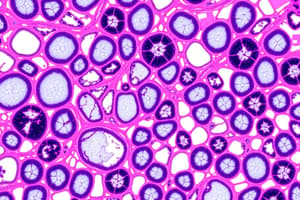Podcast
Questions and Answers
What is the primary function of epithelial tissue?
What is the primary function of epithelial tissue?
- Secretion and absorption (correct)
- Transmission of electrical impulses
- Contraction and movement
- Support and protection of organs
Which type of connective tissue stores energy in the form of fat?
Which type of connective tissue stores energy in the form of fat?
- Blood tissue
- Cartilage tissue
- Adipose tissue (correct)
- Bone tissue
Which type of muscle tissue is under voluntary control?
Which type of muscle tissue is under voluntary control?
- Smooth muscle
- Skeletal muscle (correct)
- Striated muscle
- Cardiac muscle
What type of connective tissue connects muscles to bones?
What type of connective tissue connects muscles to bones?
Which type of epithelial tissue is specialized for diffusion and filtration?
Which type of epithelial tissue is specialized for diffusion and filtration?
Flashcards
Anatomy of Tissue
Anatomy of Tissue
The study of the structure of tissues in the body.
Tissue Classification
Tissue Classification
Categorizing tissues based on their structure and function.
Epithelial Tissue
Epithelial Tissue
Sheets of cells that line surfaces and cavities in the body.
Connective Tissue
Connective Tissue
Signup and view all the flashcards
Muscle Tissue
Muscle Tissue
Signup and view all the flashcards
Study Notes
Tissues and Their Classification
- Tissues are groups of similar cells working together to perform specific functions.
- Four primary tissue types in animals: epithelial, connective, muscle, and nervous.
Epithelial Tissue
- Covers body surfaces, lines body cavities, and forms glands.
- Characterized by tightly packed cells with minimal extracellular matrix.
- Functions include protection, secretion, absorption, excretion, filtration, diffusion, and sensory reception.
- Classified based on cell shape (squamous, cuboidal, columnar) and layers (simple, stratified).
- Simple squamous: single layer of flattened cells, functions in diffusion and filtration (e.g., alveoli of lungs, lining of blood vessels).
- Stratified squamous: multiple layers of flattened cells, providing protection against abrasion (e.g., epidermis of skin).
- Simple cuboidal: single layer of cube-shaped cells, common in glands and kidney tubules (functions in secretion and absorption).
- Stratified cuboidal: multiple layers of cube-shaped cells, less common than simple cuboidal (functions in secretion and absorption).
- Simple columnar: single layer of elongated cells, common in digestive tract (functions in secretion and absorption).
- Stratified columnar: multiple layers of elongated cells, rare and functions in protection and secretion.
- Glandular epithelium forms glands that secrete substances (e.g., hormones, mucus).
- Endocrine glands secrete products directly into the bloodstream (e.g., hormones).
- Exocrine glands secrete products into ducts that open onto body surfaces or cavities (e.g., sweat glands, salivary glands).
Connective Tissue
- Supports, connects, and separates different tissues and organs.
- Characterized by a matrix (ground substance and fibers) surrounding cells.
- Functions include binding, support, protection, insulation, transportation (blood).
- Various types of connective tissue:
- Connective tissue proper: loose and dense connective tissues.
- Loose connective tissue (areolar, adipose, reticular): supports and connects tissues, stores energy, and provides immune protection.
- Dense connective tissue (regular, irregular, elastic): provides strength and support (e.g., tendons, ligaments).
- Cartilage: firm, flexible connective tissue, with specialized cells (chondrocytes) in a matrix containing collagen fibers.
- Hyaline cartilage: smooth, flexible support and reduces friction (e.g., articular cartilages, trachea).
- Elastic cartilage: maintains shape while permitting flexibility (e.g., ear).
- Fibrocartilage: strong and resists compression (e.g., intervertebral discs).
- Bone: rigid connective tissue with calcium salts and collagen fibers supporting weight, protecting organs, and serving as storage for minerals.
- Blood: fluid connective tissue that transports substances throughout the body.
- Connective tissue proper: loose and dense connective tissues.
Muscle Tissue
- Specialized for contraction and movement.
- Three types: skeletal, smooth, and cardiac muscle.
- Skeletal muscle: attached to bones, voluntary movement (e.g., biceps, quadriceps).
- Smooth muscle: in walls of internal organs, involuntary movement (e.g., stomach, intestines).
- Cardiac muscle: heart, involuntary contractions for blood pumping.
Nervous Tissue
- Specialized for communication and control.
- Composed of neurons (nerve cells) and neuroglia (supporting cells).
- Functions include sensory input, integration, and motor output.
- Neurons transmit nerve impulses.
- Neuroglia support and protect neurons.
- Found in the brain, spinal cord, and nerves.
Studying That Suits You
Use AI to generate personalized quizzes and flashcards to suit your learning preferences.



